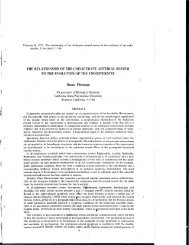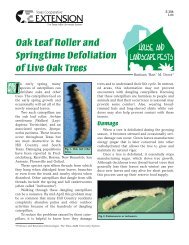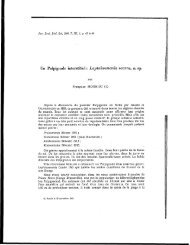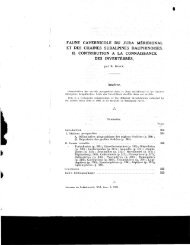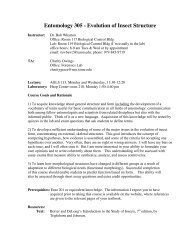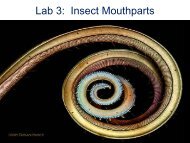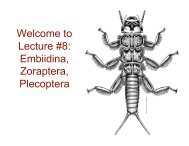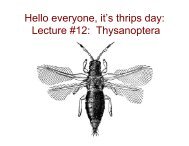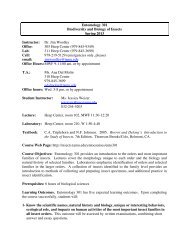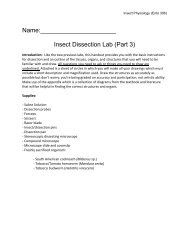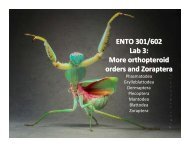Welcome to Lecture #9: Order Isoptera
Welcome to Lecture #9: Order Isoptera
Welcome to Lecture #9: Order Isoptera
Create successful ePaper yourself
Turn your PDF publications into a flip-book with our unique Google optimized e-Paper software.
<strong>Welcome</strong> <strong>to</strong><br />
<strong>Lecture</strong> <strong>#9</strong>:<br />
<strong>Order</strong> <strong>Isoptera</strong>
Phylogeny of<br />
Hexapoda<br />
To Orthoptera,<br />
Paleoptera, etc.<br />
(<strong>to</strong> Hemiptera and<br />
Holometabola)<br />
Embiidina<br />
Plecoptera<br />
Zoraptera<br />
<strong>Isoptera</strong><br />
Man<strong>to</strong>dea<br />
Blat<strong>to</strong>dea
<strong>Order</strong> <strong>Isoptera</strong><br />
1)!biting/chewing mouthparts!<br />
2)!two pairs of membranous wings, if present,<br />
approximately equal in size and shape and<br />
folding flat over body. !<br />
3)!wings shed - break off along a basal,<br />
weakened line!<br />
4)!cerci very short!<br />
5)!eusocial, with castes!
<strong>Isoptera</strong>
<strong>Isoptera</strong><br />
1)!biting/chewing<br />
mouthparts!<br />
2)!two pairs of<br />
membranous wings, if<br />
present, approximately<br />
equal in size and shape<br />
and folding flat over<br />
body. !<br />
3)!wings shed - break off<br />
along a basal,<br />
weakened line!<br />
4)!cerci very short
<strong>Isoptera</strong><br />
2)!two pairs of membranous wings,<br />
approximately equal in size and<br />
shape and folding flat over body. !
<strong>Isoptera</strong><br />
5)!eusocial, with<br />
castes!
Eusocial Insects<br />
• Overlapping generations<br />
• Castes<br />
– Division of labor<br />
– May be morphologically distinct<br />
– One or more castes are sterile<br />
• Cooperative Brood Care
<strong>Isoptera</strong> 5)!eusocial, with castes!
Colony life cycle<br />
• Large number alates released from old<br />
colony<br />
– Often after heavy rains, particularly in tropics<br />
– Weak fliers<br />
• Females attract males<br />
• The King and Queen seek suitable site for<br />
new colony<br />
• Shed wings soon after landing<br />
• Royal couple excavates a nuptial chamber<br />
• Mate and found new colony - the King<br />
doesn’t die!
Caste Determination<br />
• Castes are made up of members of both sexes<br />
• Under hormonal control<br />
• Extrinsic (environmental) fac<strong>to</strong>rs such as social<br />
interactions and the physical environment act on<br />
developmental processes<br />
• Reproductive vs. non-reproductive determined at first<br />
larval molt<br />
• In some cases caste members secrete pheromones<br />
that inhibit production of more members of same<br />
caste<br />
• Workers may destroy surplus individuals<br />
• Recent evidence suggests a role also for genetic<br />
caste determination in some termites
Most Common Castes in Termites<br />
• Primary reproductives<br />
– Queen<br />
– King<br />
– Fully developed wings and compound eyes<br />
– Most have single queen and single king<br />
– Queens exhibit PHYSOGASTRY
Alates = primary reproductives
physogastry
physogastry
Most Common Castes in Termites<br />
• Primary reproductives<br />
• Supplementary Reproductives<br />
– = neotenics<br />
– Short wing pads<br />
– Supplement supply of workers<br />
– Can take over if something happens <strong>to</strong><br />
queen
Most Common Castes in Termites<br />
• Primary reproductives<br />
• Supplementary Reproductives<br />
• Soldiers<br />
– Sterile males and females<br />
– Greatly enlarged heads and mandibles<br />
– Function in colony defense
soldiers
Rhinotermitidae and Termitidae<br />
fontanelle
soldiers
(pho<strong>to</strong>s by Dale Ward)<br />
nasutes
nasutes
Most Common Castes in Termites<br />
• Primary reproductives<br />
• Supplementary Reproductives<br />
• Soldiers<br />
• Workers<br />
– Sterile males and females<br />
– Not strongly sclerotized<br />
– Without special structual adaptations<br />
– All other tasks in colony
Most Common Castes in Termites<br />
• Primary reproductives<br />
• Supplementary Reproductives<br />
• Soldiers<br />
• Workers<br />
– Care of young<br />
– Construction of nests and galleries<br />
– House-keeping<br />
– foraging
workers
Rhinotermitidae
Termitaria
Termitaria
Termitaria
Termitaria
Termitidae
Trails of<br />
Termitidae
Termitaria
Termitaria
termitaria
Termite Nutrition<br />
• Digestion of cellulose is difficult<br />
• Most termites have flagellate<br />
pro<strong>to</strong>zoans in the gut -<br />
Trichonympha<br />
• True symbiotic relationship<br />
• Trichonympha also has<br />
bacterial symbionts!<br />
• Symbionts are lost at molts<br />
• Trophallaxis - anal fluid fed<br />
upon by other members of the<br />
colony<br />
• Termitidae - have cellulase<br />
enzymes and also a rich gut<br />
fauna, probably rely on bacteria<br />
The image cannot be displayed. Your computer may not have enough memory <strong>to</strong> open the image, or<br />
the image may have been corrupted. Restart your computer, and then open the file again. If the red x<br />
still appears, you may have <strong>to</strong> delete the image and then insert it again.
Termi<strong>to</strong>philes<br />
• Termite colonies harbor rich array of<br />
freeloaders and guests<br />
• Some are active preda<strong>to</strong>rs<br />
• Others are scavengers<br />
• Some are fed by termites in exchange<br />
for secretions that they provide <strong>to</strong> the<br />
termites
• Collembola<br />
Termi<strong>to</strong>philes<br />
• Certain species of Thysanura<br />
• Coleoptera<br />
• Hymenoptera<br />
• Diptera
Termi<strong>to</strong>philes - staphylinid beetles
Odon<strong>to</strong>machus - lives in nests of Termitidae
Rotating termite mound<br />
bioluminescent larva<br />
Many thanks <strong>to</strong> Emily Dinh!<br />
Glowing<br />
termite<br />
mounds



